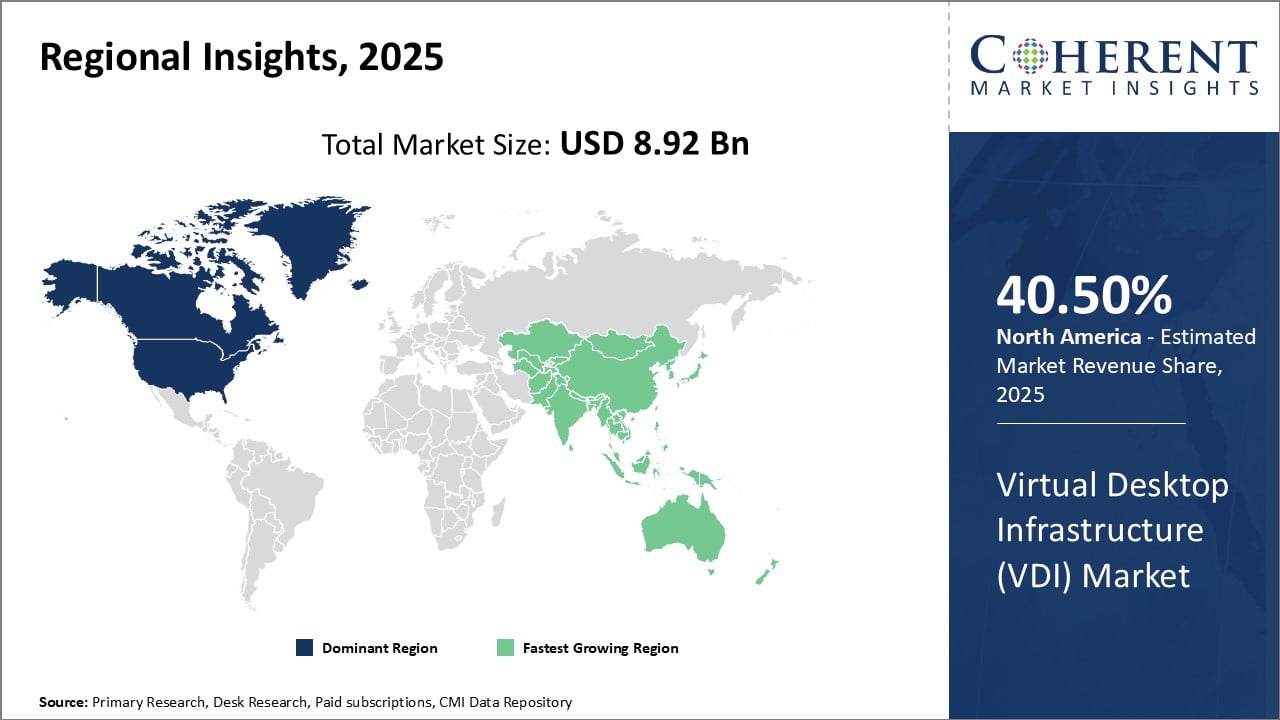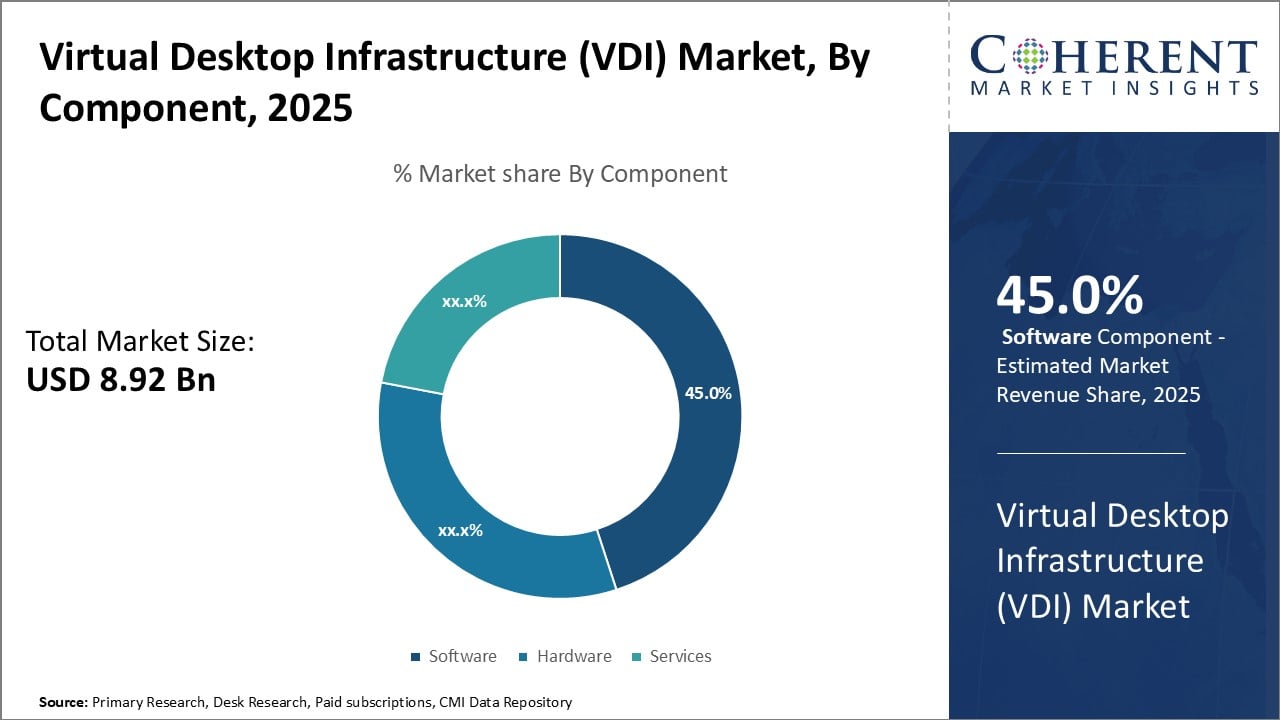The Virtual Desktop Infrastructure (VDI) market size is expected to reach US$ 23.43 Bn by 2032, from US$ 8.92 Bn in 2025, at a CAGR of 14.8% during the forecast period.
Virtual Desktop Infrastructure (VDI) refers to the technology used to create a virtual desktop that runs on a centralized server in a data center rather than a local client device. VDI provides a virtualization layer that allows desktop operating systems to run in virtual machines on servers in the data center. This centralizes management, enhances security, and improves resource allocation. The key advantages of VDI include simplified desktop management, increased security, lower costs, and improved productivity.
The Virtual Desktop Infrastructure (VDI) market is segmented based on component, organization size, VDI type, delivery model, end user, and region. By component, the market is segmented into software, hardware, and services. The software segment accounts for the largest market share due to the high demand for VDI software and platforms from enterprises.
Virtual Desktop Infrastructure (VDI) Market Regional Insights:
- North America is expected to be the largest market for Virtual Desktop Infrastructure (VDI) during the forecast period, which accounted for over 40.5% of the market share in 2025. The growth of the market in North America is attributed to the early adoption of VDI solutions and the presence of major VDI vendors in the region.
- Europe is expected to be the second-largest market for Virtual Desktop Infrastructure (VDI), which accounted for over 33.2% of the market share in 2025. The growth of the market in Europe is attributed to the rising digital workplace transformation and virtualization trends in countries like the U.K., Germany, and France.
- Asia Pacific is expected to be the fastest-growing market for Virtual Desktop Infrastructure (VDI), growing at a CAGR of over 15.3% during the forecast period. The growth of the market in Asia Pacific is attributed to increasing IT infrastructure developments and enterprise mobility requirements in emerging economies like China, India, and Australia.
Figure 1. Global Virtual Desktop Infrastructure (VDI) Market Share (%), by Region, 2025

To learn more about this report, Download Free Sample
Virtual Desktop Infrastructure (VDI) Market Drivers:
- Need to Improve Data Security: With rising cybersecurity threats, data breaches, and strict data compliance mandates, enterprises are looking to adopt solutions to enhance data security. VDI solutions store data centrally on enterprise servers rather than endpoint devices. This eliminates data loss risks and enables the centralized management of sensitive information. VDI solutions provide tighter access controls, remote device locking, multi-factor authentication (MFA), and better auditing. According to reports, 52% of companies cite security as the major reason for adopting VDI. The need for improved data security will spur VDI adoption.
- Cost Reduction and Operational Efficiency: VDI solutions reduce hardware costs as the processing power and storage needed is provided by the centralized server. IT teams can quickly scale capacity or optimize hardware costs based on changing requirements. VDI also reduces installation, configuration, and support costs by simplifying IT management. According to estimates 2023, VDI solutions can lower endpoint energy costs by around 70%. With tight IT budgets, organizations are implementing VDI solutions to drive cost optimization and operational efficiencies.
Virtual Desktop Infrastructure (VDI) Market Opportunities:
- Adoption of Cloud-Based VDI Solutions: Cloud-based VDI solutions are enabling anytime, anywhere access to virtualized workspaces while eliminating hardware dependencies. Plus, cloud-based VDI offers quicker deployment, built-in disaster recovery, and consumption-based billing. For example, healthcare witnessed massive digital transformation during the pandemic with greater adoption of telemedicine and remote patient monitoring. This surge in virtual healthcare appointments and digital health records management has increased the demand for secure, centralized and remotely accessible computing resources. According to data from UNESCO, as of June 2021, approximately 160 countries were providing remote learning opportunities to students impacted by Covid-19 school closures, impacting over 1.6 billion learners. VDI facilitates such remote learning initiatives through secure virtual desktops.
- Demand from Emerging Verticals: VDI adoption in sectors, such as education, healthcare, government, and retail, is increasing rapidly. These verticals handle sensitive private data of customers and require capabilities to securely enable remote work. For instance, various states in the U.S. implemented VDI technology for telehealth services and distance learning during the pandemic. Rising implementation across emerging verticals will open new market avenues.
- Integration of AI and Analytics: VDI vendors are integrating AI (Artificial intelligence)and data analytics capabilities to enhance user experience, improve resource utilization, and provide predictive insights. For instance, in July 2021, VMware introduced AI-powered smart workspace technology in Workspace ONE platform to optimize virtual app performance. The adoption of AI-enabled proactive management, user behavior analysis, and self-healing capabilities that will enable smarter, efficient VDI deployments, thus expanding the market size.
- Partnerships with Managed Service Providers: Leading VDI vendors are entering partnerships with managed service providers (MSPs) to increase market penetration among SMEs. MSPs offer fully-managed VDI solutions at a lower TCO to help businesses overcome expertise and budget constraints. Parallels recently partnered with a managed cloud provider, Cogeco Peer1 to deliver hosted VDI services in Canada leveraging Microsoft Azure. Similar partnerships will help providers target untapped markets and fuel growth.
Virtual Desktop Infrastructure (VDI) Market Report Coverage
| Report Coverage | Details | ||
|---|---|---|---|
| Base Year: | 2024 | Market Size in 2025: | USD 8.92 Bn |
| Historical Data for: | 2020 To 2024 | Forecast Period: | 2025 To 2032 |
| Forecast Period 2025 to 2032 CAGR: | 14.8% | 2032 Value Projection: | USD 23.43 Bn |
| Geographies covered: |
|
||
| Segments covered: |
|
||
| Companies covered: |
VMware, Citrix Systems, Microsoft, Cisco Systems, Oracle, Red Hat, Huawei, Hewlett Packard Enterprise, Parallels International, Dynabook Americas, Dell Technologies, IGEL Technology, Amazon Web Services, Nutanix, 10ZiG Technology, Splashtop, Nerdio, HiveIO, SherWeb, and Login VSI |
||
| Growth Drivers: |
|
||
| Restraints & Challenges: |
|
||
Uncover macros and micros vetted on 75+ parameters: Get instant access to report
Virtual Desktop Infrastructure (VDI) Market Trends:
- Hyperconverged Infrastructure: Hyperconverged infrastructure (HCI) is gaining rapid traction in VDI deployments due to benefits like simplified management, enhanced scalability, and reduced costs. Vendors, such as Cisco, Dell, and HPE, offer VDI-optimized HCI for containerized app and desktop delivery. According to research, over 60% of IT leaders prefer HCI platforms for virtual desktop and app delivery. HCI-based approach is displacing traditional three-tier architecture for VDI.
- Integration with Edge Computing: VDI adoption is increasing in remote offices and branch locations to deliver consistent workspaces while reducing latency. Key providers, such as VMware and Nutanix, are integrating VDI with edge computing to allow processing user requests at edge locations rather than data centers. According to Nutanix, implementing VDI at the edge can lower latency by as much as 75%. The mmergence of edge computing will enable the expansion of VDI capabilities to remote sites and IoT.
- SaaS-based Delivery Models: Leading VDI vendors are offering solutions based on a SaaS delivery model, enabling businesses to consume desktops virtually via monthly/annual subscriptions. Citrix DaaS, VMware Horizon Cloud, and other SaaS VDI solutions simplify deployments while delivering flexible pricing. The SaaS models provide vendors opportunities to attract new customers, driving market revenues.
Virtual Desktop Infrastructure (VDI) Market Restraints:
- Infrastructure Complexities: VDI deployments involve several complex components like hypervisors, networking, storage, virtualization software, and web-enabled access devices. Integrating and maintaining all these components require skilled IT expertise and dedicated resources. Complexity concerns can hinder mainstream VDI adoption.
- Resistance to Change: Migrating from traditional physical desktops to virtualized workspaces requires significant changes in workflows, policies, and culture. Many organizations, especially in emerging regions, display inertia or resistance to adopt new technologies. Such reluctance can restrict market expansion.
- Licensing Costs: While VDI reduces hardware costs, it leads to increased software licensing costs for virtualization OS and apps. Per-user or per-device licensing models can significantly inflate costs for businesses with a large workforce. High licensing costs continue to impede the market growth.
Recent Developments:
New product launches:
- In October 2022, VMware launched vSphere 8, its latest virtualization platform, to optimize application development, deployment, and security for modern workloads
- In June 2022, Citrix launched DaaS solution, Citrix Managed Desktops, a scalable cloud-hosted offering built on Microsoft Azure. It simplifies management and delivery of virtual apps and desktops.
Acquisition and partnerships:
- In October 2022, Nerdio acquired Hubworks to strengthen its Azure-based VDI solution and expand in the European market
- NetApp, a leader in cloud data services, announced the acquisition of CloudJumper, a leading cloud software company in the VDI and RDS markets. The acquisition would enable NetApp to successfully manage the most challenging problems of virtual desktop services and application, allowing customers to deploy, manage, monitor, and optimize those environments as a totalsolution from a single company on the public cloud of their choice.
- In August 2022, Teradici entered a new partnership with LG to deliver secure remote access to high-performance workstations from anywhere
Figure 2. Virtual Desktop Infrastructure (VDI) Market Share (%), By Component, 2025

To learn more about this report, Download Free Sample
Top Companies in the Virtual Desktop Infrastructure (VDI) Market:
- VMware
- Citrix Systems
- Microsoft
- Cisco Systems
- Oracle
- Red Hat
- Huawei
- Hewlett Packard Enterprise
- Parallels International
- Dynabook Americas
- Dell Technologies
- IGEL Technology
- Amazon Web Services
- Nutanix
- 10ZiG Technology
- Splashtop
- Nerdio
- HiveIO
- SherWeb
- Login VSI
Definition:
The Virtual Desktop Infrastructure (VDI) market refers to the solutions, hardware, software, and services that enable enterprises to create virtualized desktop environments hosted on on-premise or cloud servers. VDI technology provides organizations a scalable and flexible digital workspace solution to empower today's mobile and remote workforce while saving costs and improving data security. The global VDI market is gaining huge traction among businesses of all sizes looking to modernize IT infrastructure and support emerging hybrid work models.
Few Other Promising Reports in Information and Communication Technology Industry
Share
Share
About Author
Monica Shevgan has 9+ years of experience in market research and business consulting driving client-centric product delivery of the Information and Communication Technology (ICT) team, enhancing client experiences, and shaping business strategy for optimal outcomes. Passionate about client success.
Missing comfort of reading report in your local language? Find your preferred language :
Transform your Strategy with Exclusive Trending Reports :
Frequently Asked Questions
Select a License Type
EXISTING CLIENTELE
Joining thousands of companies around the world committed to making the Excellent Business Solutions.
View All Our Clients




